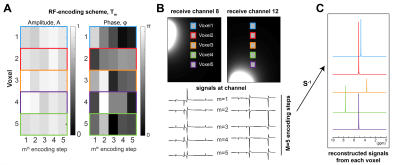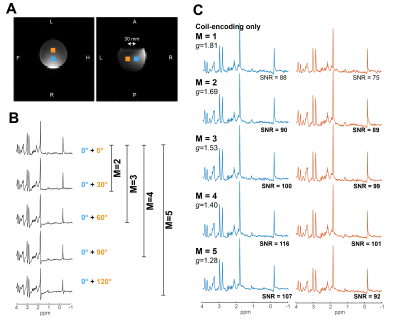Adam Berrington1, Penny Gowland1, and Richard Bowtell1
1Sir Peter Mansfield Imaging Centre, School of Physics and Astronomy, University of Nottingham, Nottingham, United Kingdom
1Sir Peter Mansfield Imaging Centre, School of Physics and Astronomy, University of Nottingham, Nottingham, United Kingdom
Phase
and amplitude signal modulation was shown to improve the g-factor of reconstruction for 5 voxels in simulation. Phantom spectra
from two-voxels were acquired over M=1…5 encoding steps with 30° phase
increments and were of higher SNR than reconstructing using coil-encoding
alone.

Fig.1: RF-encoding simulated with unique spectral
peaks assigned to 5 voxel ‘locations’ (coloured regions). A) Encoding scheme applied to each voxel at each encoding step, $$$m=1…5$$$. Amplitude was weighted
randomly between 0.8 and 1 and phase modulated between 0 and 180$$$^{\circ}$$$. B) Receive
sensitivities (shown for two coils),
which are combined with (A) to generate weighted signals at each channel
for each encoding step, $$$m$$$. Signals are concatenated over M=5 steps. C)
Inversion of the system matrix, $$$\bf S$$$, reveals reconstructed signals from each voxel.

Fig. 4: Data
acquired from two voxels (voxel 1=blue; voxel 2=orange) in a phantom (A) using
proposed RF-encoded technique with an increasing number of encoding steps, M. (B)
Combined signal (not unfolded) from all receive coils shows shot-to-shot
variation in phase from (0°,30°,60°,90°,120°) modulation on voxel 2 using the dual-band pulses.
(C) Reconstructed data using RF-encoding (steps M=2-5) are shown below coil-encoding
only (M=1). The spectral SNR and effective g-factor values are stated next to
each encoding.
